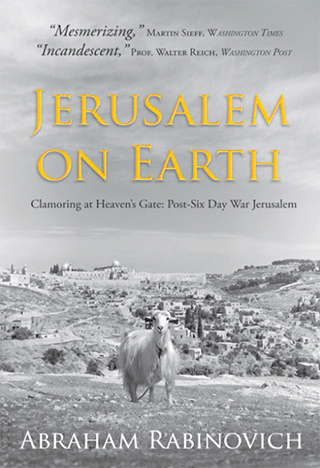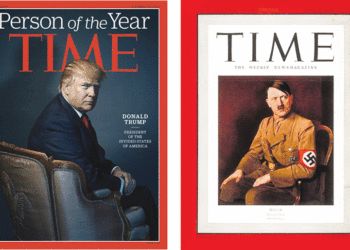Reviewed by NEAL GENDLER
Abraham Rabinovich sees and examines things that others don’t know or barely notice.
For example, there’s Sister Abraham, born Kirsten Pedersen in Denmark, “the only white nun known to have been accepted into the Ethiopian Orthodox church,” he says.
University educated, master of 15 languages, her published history of the Ethiopians in the Holy Land includes the thwarting of Italy’s 1939 attempt to take over the church’s Jerusalem property after conquering Ethiopia. Thanks go to a neighbor across the street, lawyer Nathan Marein, a Jew.
Unusual people pop up often in Rabinovich’s Jerusalem on Earth, first published in 1988 and updated, expanded and republished this year. It paints Jerusalem and its people with characteristics and concerns both old and continuing. Rabinovich calls moral dilemmas such as trusting friendly Arabs or suspecting all Arabs “everyday fare.”
It’s the fourth book by New York-born Rabinovich, who came to Israel five days before the 1967 war, covered the battle for Jerusalem and joined the Jerusalem Post for 25 years. He began on the municipal and police beats, “low in the newsroom’s pecking order but superb positions from which to feel a city’s pulse,” he says.
That meant a lot of time around famed Teddy Kollek, indefatigable mayor for 28 years. Kollek shaped the modern city, tried to unite its populations and founded the Israel Museum. The Kollek chapter is an informative delight.
Jerusalem, which Rabinovich calls “an anecdotal overview of the turbulent post Six-Day War decades,” is a joy to read. Chapters seldom include dates, but all feel fresh.
We meet Hamdi Nubani, a Muslim learned in the Talmud, and young Hanan, a police spy amid the black hats of Mea Shearim. In a different chapter, Rabinovich describes being there as “thousands of black-clad figures” hurry past to greet the new Satmar rebbe.
For a moment, “squinting up the narrow winding street, … one was in the universal shtetl, vibrant with life before the great darkness.”
There’s Flinders Petrie, English pioneer of scientific archaeology, buried without his head, which he’d insisted be sent to Britain for scientific study, and tefillin-maker Leib, ultra-Orthodox and anti-Zionist, hooked on philosophy in several languages and fascinated by and lecturing on Nietzsche.
Also, Frida, an Argentine who in 1981 tells Rabinovich of a vivid vision that the Ark of the Covenant is buried and radiating energy from within a circle of stones atop Masada.
Those are among the quirkier people in Rabinovich’s 29 short chapters. Others illustrate the varied lives, struggles, views and beliefs of Jerusalemites. It’s all fascinating and so beautifully written you hardly notice that you’re reading.
A detailed chapter describes how an Australian Christian, Dennis Rohan, plotted and set fire to part of the Temple Mount’s Al-Aqsa Mosque. Another tells of the breaking of the taboo of performing Wagner.
Rabinovich recounts how after the 1967 war, Jerusalem’s dividing walls came down and Arabs poured into the western portion. Alas, an Arab summit in summer 1967 passed the famous “three nos”: no peace, no recognition and no negotiations. Fewer Arabs came over, good will diminished, Arab terrorism began.
He tells of intra- and inter-religious tensions on Mount Zion, where in one building, many Jews say the first floor holds King David’s tomb and many Christians say the second floor holds the room of Jesus’ Last Supper. In fact, he says, the building dates from the Crusader period.
Rabinovich also describes ongoing struggles: Jewish religious-secular tensions, haredi violence, divisions among the ultra-Orthodox and Christian turf battles.
“It has been a long time since anyone turned the other cheek in Jerusalem,” he says. “Jews, Christians and Moslems have ever jostled each other for position to the gateway to heaven. However, each community understood implicitly that Jerusalem did not belong to them alone.”
One of the most charming stories, “The Neighbors,” begins and ends the book.
From his balcony, Haim Machsumi looks into Jordanian Jerusalem as an Arab family moves into a previously deserted house in no-man’s land. Soon, he and an old man in that family look at each other often.
After weeks of this, Haim says an Arabic “good morning” across the wire fence. The Arab man, Abu Ali, returns the greeting. Machsumi, his wife Rachel and members of Ali’s family start exchanging frequent greetings. Then comes the Six-Day War, during which Machsumi and his family flee to a shelter.
Returning home, he sees Ali waving a stick with a white cloth of surrender. Machsumi passes through a breach in the fence and runs to Ali. “At last,” Machsumi says, “we can finally shake hands.”
***
Neal Gendler is a Minneapolis writer and editor.
(American Jewish World, November 2024)




















